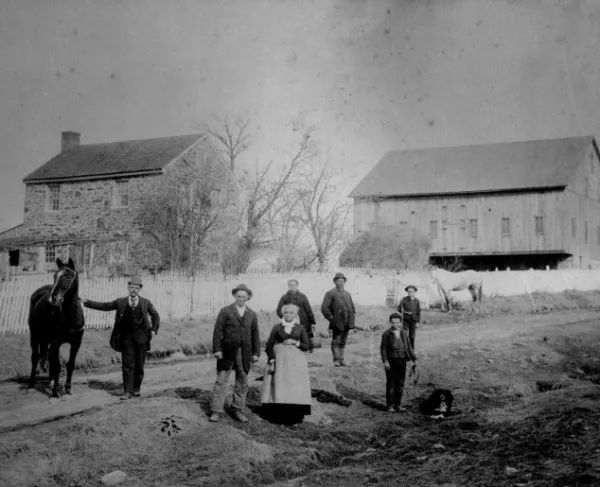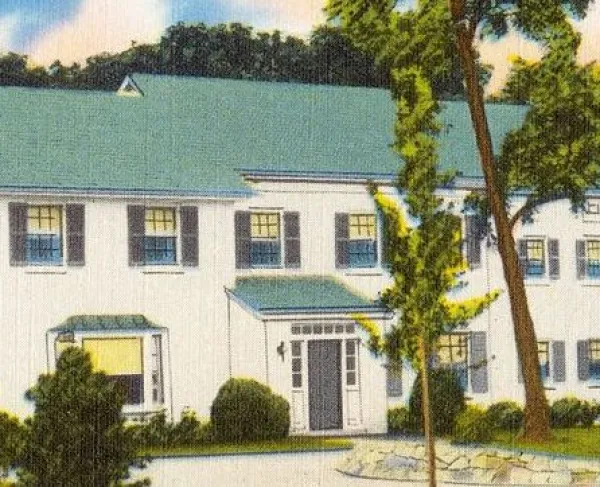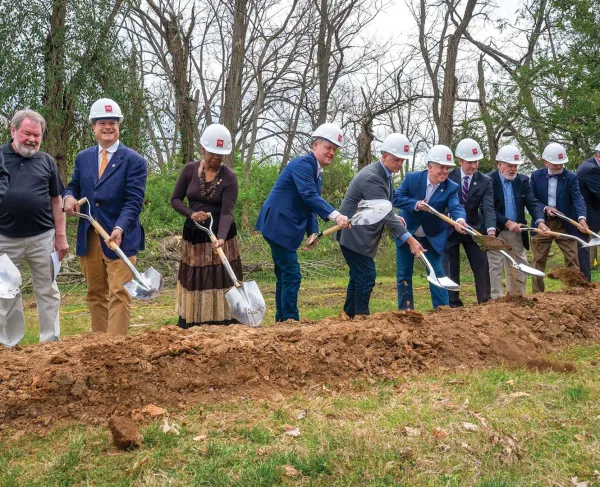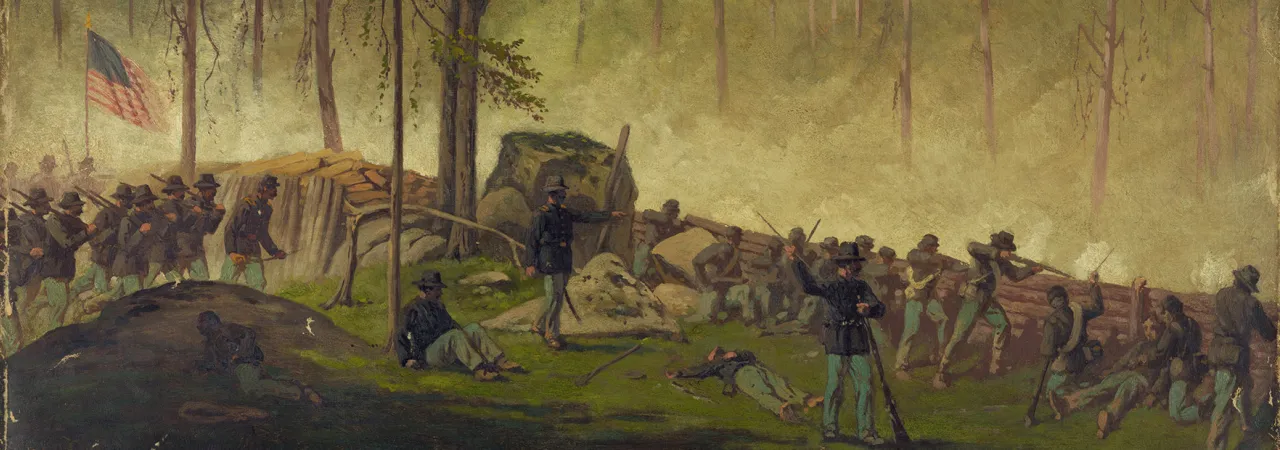
Few places saw fighting that was as prolonged and deadly as it was at Culp’s Hill during the battle of Gettysburg. Witnessing fighting on both July 2 and July 3, 1863, Union troops atop Culp’s Hill held against repeated Confederate assaults that pushed up the wooded slope in vain. On the southern side of the hill on July 3, towards Spangler’s Spring, soldiers of the 27th Indiana and 2nd Massachusetts launched their own futile attacks against positions Confederate troops had taken. But, when day dawned on July 4, Confederate troops had mostly withdrawn from their positions around the hill back towards town as they prepared to retreat. Though there was still some skirmishing or sharpshooting north of town as the Army of Northern Virginia moved away, Culp’s Hill was relatively safe. As the Union soldiers nervously peeked above their earthworks and slowly proceeded down the bloodied slopes, they were met with all the horrors of the aftermath of battle. In addition to recovering equipment and taking the wounded to field hospitals, the soldiers were tasked with the burial of the dead.

The regimental history for the 149th New York summarized the feelings and sights of July 4 and 5. It states: “The men were awakened at daylight to a glorious Fourth of July, with the salutation, ‘The enemy has skedaddled, and we are masters of the field.’ Here had been fought a great battle and the Union men were victorious… Soon after daylight the men commenced traversing the battlefield, and then fully realized the great price paid for the victory. The impressions received during that morning walk will never be effaced from memory. It made the men sick both in body and mind. They had been nearly without food for forty-eight hours, yet it was with difficulty that they could retain food in their stomachs. The havoc in the Union lines was terrible, but among the enemy it was still more so…” Corporal Charles Teasdale of the 14th Brooklyn witnessed similar sights on his portion of the hill, noting “In every direction the dead lay thick and overlaying each other in large numbers especially behind the boulders. … This place was in its half dark lonesomeness, a veritable horror spot. So many ghastly evidences of violent and painful death abound[ed] here.” As the Union wounded were removed to field hospitals, the victors were now responsible for bringing Confederate wounded into their lines and moving them for treatment as well. Nathan Parmeter of the 29th Ohio wrote that late at night on July 3, “we could hear the wounded in our front hollow for help,” and the end of battle on July 4 allowed Union soldiers to venture forth to treat the enemy wounded. The detritus of war included not only the dead and wounded but also the material of war. Parmeter noted on the 5th that his regiment alone “gathered up some 500 guns,” while a member of the 27th Indiana described “a back ground of an infinite amount of guns and parts of guns, scattered everywhere, torn and injured clothing and equipments.”
Other Union troops seemed less bothered by the death they were surrounded by. Instead, they took pleasure in the fact they had taken part in a decisive victory, and pride in the fact it was now Independence Day. In addition to the regimental history for the 149th New York that declared a glorious Fourth, one soldier from the 111th Pennsylvania wrote home of the Fourth of July in a more triumphant manner with fewer gory details, noting “You ask me how I spent my fourth of July. We celebrated the third all day killing Rebs. And there was the greatest display of fireworks displayed the 3rd that was ever witnessed in Pa…and I spent a part of the 4th in roaming over the Battlefield looking at dead Rebs and talking with those who were left wounded by their men on the field to die.” Some Union soldiers had apparently become hardened to some of the effects of battle or were coping with the horror by finding solace in such a great victory.
Though the awful sights of death impacted soldiers, other senses such as smell were assailed by the detritus of battle. Sergeant Meyer of the 148th Pennsylvania wrote that “The stench on the battlefield was something indescribable, it would come up as if in waves and when at its worst the breath would stop in the throat; the lungs could not take it in, and a sense of suffocation would be experienced.” Another soldier noted that as pioneers worked to dig trenches for the burial of the dead that “Whiskey had been issued to the Brigade Pioneers, as the stench was almost unbearable.” One veteran of the 147th Pennsylvania recorded “The stench from these dead was something fearful. While the trenches were being dug we gathered the corpses and the stench was so great that we were ordered not to carry any more until the pioneers had finished their work. Some of the pioneers got sick and had to quit.” As this soldier described, pioneers cleared underbrush and dug long burial pits while other soldiers brought the dead for burial.
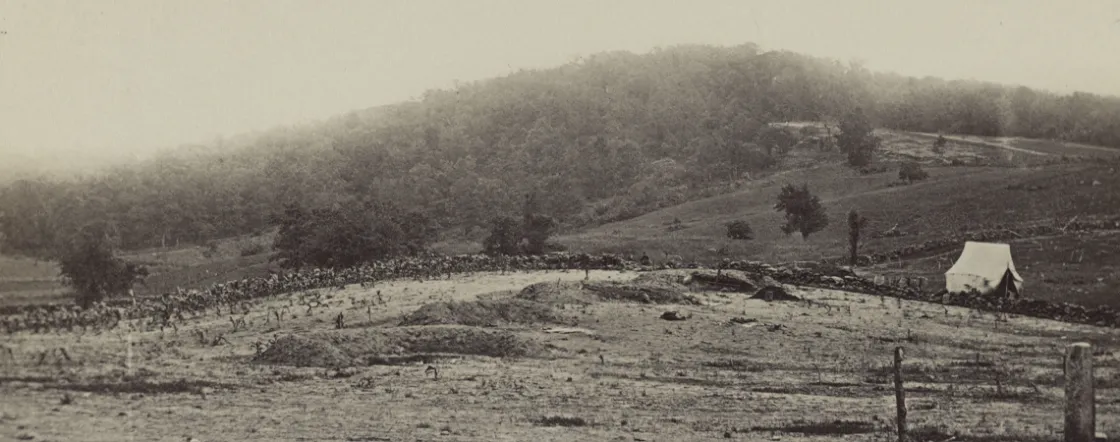
The reek of death and decay was so pervasive that it forced soldiers to resort to measures such as covering their faces with neckerchiefs doused in peppermint oil so that they could stand the task assigned to them. Despite the trying conditions of the aftermath of battle and the rocky soil, civilian J. Howard Wert was impressed by the professionalism of the burials. He recorded "The dead here were more carefully interred than on almost any other portion of the field. Deep, wide trenches were made in which the corpses were placed side by side and well covered. On an adjacent oak the burial parties would hew off the bark from one side and place in lead pencil the number buried in the trench; thus ’73 rebs buried to the right’: ’45 rebs in this trench,’ etc. There were seventeen of these trenches on a space not exceeding five or six acres, in which the numbers varied from a dozen to 70 or 80." Even now, with the dead of the trenches long since reinterred elsewhere, hints of them can be seen on the landscape as physical reminders of what the landscape witnessed.
In addition to the massive burial trenches along the slopes of Culp’s Hill, soldiers of the 27th Indiana carefully recorded how they buried their dead. Having launched a failed attack at Spangler’s Spring on the morning of July 3, the regiment lost 16 killed and 139 wounded, 18 of whom died of their wounds. With the Confederate retreat, they were able to venture back into the Spangler Meadow, where a veteran recorded that in addition to the dead men and equipment strewn across the field, “Still another very revolting feature of a great battle-field that might not be thought of, if not mentioned, is that the surface of the ground, besides being everywhere gashed, seamed and trampled, is blackened, greased and besmirched, until one cannot think of remaining upon it or near it.” As others gathered up military supplies and carried the wounded away for treatment, some Hoosiers prepared to bury their dead. Samuel Fletcher of the 27th Indiana recorded that “The boys had gathered twenty-eight in one place and dug a long trench about six and one half feet wide, and long enough to lay the bodies, wrapped up in their blankets, side by side, with head boards to etch the letters being cut in with their knives.” Though buried in a trench, these soldiers were lucky enough to have been buried by their friends and comrades and buried with individual headboards. Most of the men were buried on William McAllister’s farm, between the Baltimore Pike and Rock Creek. Ten members of the 27th Indiana are listed as being buried along the property, mostly near the Mill Dam, along with fifteen members of the 2nd Massachusetts, all buried nearby their comrades, each in identified graves. These comprise most of their soldiers who were killed in action during the regiments’ July 3 attack. The men from this burial location were later reburied in the National Cemetery, identified today because of the work of their comrades.
The aftermath of battle is a horrible thing, bereft of all the imagined glories of combat. After every battle the survivors, who had already endured the horrors of confrontation, were then forced to endure the inevitable outcome. Discarded equipment covered Culp’s Hill, along with the bodies of the dead and wounded. The sights of carnage, the sounds of the wounded, and the scent of death all assailed soldiers in a similar fashion to the bullets that rained around them during the battle. These sensory experiences often stuck with soldiers just as much as memories of combat did. Now, with recent preservation work, the slopes of Culp’s Hill look more similar to 1863 than they have in decades. As visitors explore the area to better understand the battle, it is also worth considering how the soldiers experienced the aftermath of battle there and to imagine the sights, sounds, and scents that the wooded slopes once experienced.
Further Reading
- A Strange and Blighted Land, Gettysburg: The Aftermath of a Battle, By: Gregory A. Coco.
- Gettysburg: Culp’s Hill & Cemetery Hill, By: Harry W. Pfanz.
We're on the verge of a moment that will define the future of battlefield preservation. With your help, we can save over 1,000 acres of critical Civil...
Related Battles
23,049
28,063

